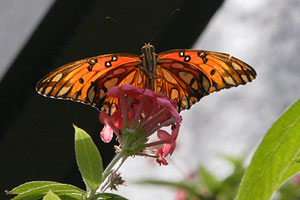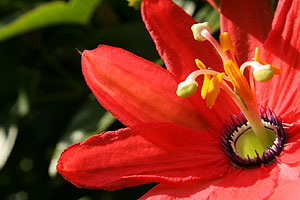 Gulf Fritillary Butterfly (Agraulis vanillae)I awoke on Saturday morning to a sign that the deep freeze that had locked me into seasonal emotional torpor might be lifting: I saw a butterfly. She was a Gulf Fritillary, sunning her wings on the passion vine outside my window. The warmth had brought out my pollinating friend, as well as my hope for a morning cup of coffee in the sunshine. Joy had returned to Oakland!
Gulf Fritillary Butterfly (Agraulis vanillae)I awoke on Saturday morning to a sign that the deep freeze that had locked me into seasonal emotional torpor might be lifting: I saw a butterfly. She was a Gulf Fritillary, sunning her wings on the passion vine outside my window. The warmth had brought out my pollinating friend, as well as my hope for a morning cup of coffee in the sunshine. Joy had returned to Oakland!
As I sipped coffee on the back porch, she sipped nectar from a flower. Where had she been while it was so cold? Would that cold bring about fewer nectar flowers and host plants? Did her carefully laid eggs freeze? Then I pondered, is it the cold, or the rising heat, that she and I should really be concerned with?
Butterflies, the posterbug for pollination, are in trouble. Due to issues such as habitat loss, pesticide use and invasive species, butterflies struggle to find nectar for eating and host plants for their caterpillar babies, who happen to be particular. Now, it seems, a new problem for butterflies has strolled into town, global warming!
 Passion FlowerAccording to Laurie Davies Adams of the Coevolution Institute, studies on various butterflies, including the Bay Checkerspot (Euphydryas editha bayensis), suggest that climate change will push the insect to extinction. The plants it depends on for food will shift their growing season, so when eggs hatch, the caterpillars will be left with no plant food on their plates. Scientists are worried. If we can't stop global warming today or tomorrow, then what can we do for the endangered Bay checkerspot?
Passion FlowerAccording to Laurie Davies Adams of the Coevolution Institute, studies on various butterflies, including the Bay Checkerspot (Euphydryas editha bayensis), suggest that climate change will push the insect to extinction. The plants it depends on for food will shift their growing season, so when eggs hatch, the caterpillars will be left with no plant food on their plates. Scientists are worried. If we can't stop global warming today or tomorrow, then what can we do for the endangered Bay checkerspot?
Some have suggested the semi-radical concept of assisted migration. For butterflies, this would mean picking some up and moving them somewhere cooler. While I also feel compelled to move animals out of harms way, I wonder about the long term outcome of such a move. Sure, it worked for the grey wolf, but look what happened when we moved the cane toad. Other questions arise, such as, which butterfly species shall we move? Where? Should we really play this role?
